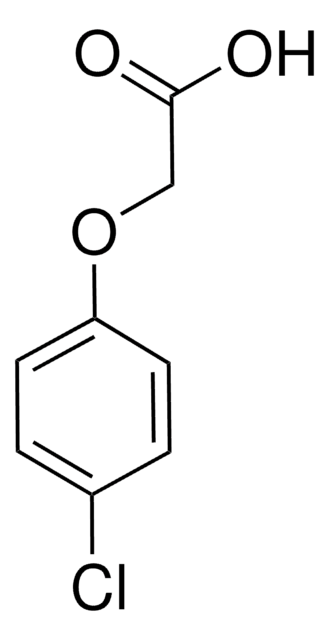25890
4-Chlorphenoxyessigsäure
≥98.0% (T)
Synonym(e):
4-CPA
Anmeldenzur Ansicht organisationsspezifischer und vertraglich vereinbarter Preise
Alle Fotos(3)
About This Item
Empirische Formel (Hill-System):
C8H7ClO3
CAS-Nummer:
Molekulargewicht:
186.59
Beilstein:
1211804
EG-Nummer:
MDL-Nummer:
UNSPSC-Code:
12352100
PubChem Substanz-ID:
NACRES:
NA.22
Empfohlene Produkte
Assay
≥98.0% (T)
Form
powder
Funktionelle Gruppe
carboxylic acid
chloro
SMILES String
OC(=O)COc1ccc(Cl)cc1
InChI
1S/C8H7ClO3/c9-6-1-3-7(4-2-6)12-5-8(10)11/h1-4H,5H2,(H,10,11)
InChIKey
SODPIMGUZLOIPE-UHFFFAOYSA-N
Suchen Sie nach ähnlichen Produkten? Aufrufen Leitfaden zum Produktvergleich
Allgemeine Beschreibung
4-Chlorophenoxyacetic acid is a herbicide. Degradation of 4-chlorophenoxyacetic acid in aqueous medium by advanced electrochemical oxidation processes, using an undivided cell containing a Pt anode has been reported.
Anwendung
- Innovative adsorbents for chemical analysis: The application of three-dimensional material CZIF-8/CS-MS was explored as adsorbents for the determination of plant growth regulators including 4-Chlorophenoxyacetic acid in traditional Chinese medicine, improving the precision and efficiency of chemical residue analysis (Zhang et al., 2024).
Signalwort
Warning
H-Sätze
Gefahreneinstufungen
Acute Tox. 4 Oral
Lagerklassenschlüssel
11 - Combustible Solids
WGK
WGK 1
Flammpunkt (°F)
Not applicable
Flammpunkt (°C)
Not applicable
Persönliche Schutzausrüstung
dust mask type N95 (US), Eyeshields, Gloves
Hier finden Sie alle aktuellen Versionen:
Besitzen Sie dieses Produkt bereits?
In der Dokumentenbibliothek finden Sie die Dokumentation zu den Produkten, die Sie kürzlich erworben haben.
Song Zhu et al.
Food science and biotechnology, 29(11), 1587-1595 (2020-10-23)
Determination of phytohormones have attracted increasing attentions in food safety field. In this study, an efficient and quantitative method was developed which can simultaneously determinate thirteen phytohormones in fruits and vegetables using solid phase extraction (SPE) combined with high performance
Sze Chieh Tan et al.
Talanta, 216, 120962-120962 (2020-05-28)
Two miniaturized sample preparation techniques, ultrasound-assisted emulsification microextraction (USAEME) and micro-solid-phase extraction (μ-SPE) have been integrated for the pre-concentration of four polar chlorophenoxy acid (CPA) herbicides from environmental aqueous samples. An metal-organic framework, MIL-101(Cr), characterized by its high porosity and
G Carbonara et al.
Farmaco (Societa chimica italiana : 1989), 56(10), 749-754 (2001-11-23)
2-(4-Chloro-phenoxy)propanoic and 2-(4-chloro-phenoxy)butanoic acids are compounds known to block chloride membrane conductance in rat striated muscle by interaction with a specific receptor. In the present study, a series of chiral analogues has been prepared and tested to evaluate the influence
K T Ranjit et al.
Environmental science & technology, 35(7), 1544-1549 (2001-05-12)
The photocatalytic degradation of p-chlorophenoxyacetic acid has been investigated in oxygenated aqueous suspensions of lanthanide oxide-doped TiO2 photocatalysts. Complete mineralization was achieved. The enhanced degradation is attributed to the formation of Lewis acid-base complex between the lanthanide ion and the
Birame Boye et al.
Environmental science & technology, 36(13), 3030-3035 (2002-07-30)
The herbicide 4-chlorophenoxyacetic acid (4-CPA) has been degraded in aqueous medium by advanced electrochemical oxidation processes such as electro-Fenton and photoelectro-Fenton with UV light, using an undivided cell containing a Pt anode. In these environmentally clean methods, the main oxidant
Unser Team von Wissenschaftlern verfügt über Erfahrung in allen Forschungsbereichen einschließlich Life Science, Materialwissenschaften, chemischer Synthese, Chromatographie, Analytik und vielen mehr..
Setzen Sie sich mit dem technischen Dienst in Verbindung.







